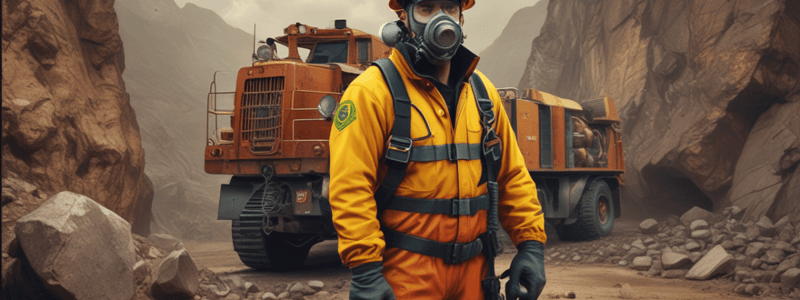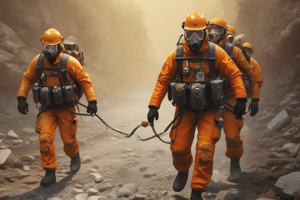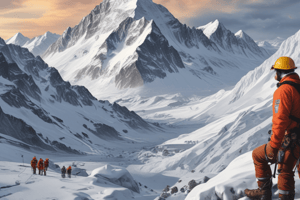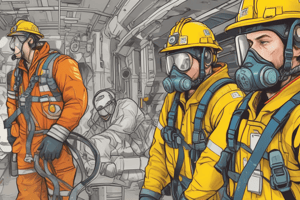Podcast
Questions and Answers
What is the primary function of a protective hood in firefighting?
What is the primary function of a protective hood in firefighting?
- Protecting the body from heat and cuts
- Protecting the ears from excessive noises
- Protecting the hands from heat and abrasions
- Protecting parts of the face not covered by the collar or helmet (correct)
What is the purpose of bunker boots in firefighting?
What is the purpose of bunker boots in firefighting?
- Protecting the eyes from foreign matter
- Protecting the hands from heat and abrasions
- Protecting the body from heat, cuts, and abrasions
- Protecting the feet from cuts and abrasions from the top and bottom (correct)
What is the primary function of respiratory protection in firefighting?
What is the primary function of respiratory protection in firefighting?
- Protecting the eyes from foreign matter
- Protecting against heated gases and toxic atmospheres (correct)
- Protecting the body from heat, cuts, and abrasions
- Protecting the ears from excessive noises
What is the Fire Triangle?
What is the Fire Triangle?
What is one of the exceptions to the Fire Triangle theory?
What is one of the exceptions to the Fire Triangle theory?
How can a fire be extinguished?
How can a fire be extinguished?
What is the result of thermal energy release in a fire?
What is the result of thermal energy release in a fire?
What is smoke composed of?
What is smoke composed of?
What is the purpose of eye protection in firefighting?
What is the purpose of eye protection in firefighting?
What is the purpose of the Personal Alert Safety System (PASS)?
What is the purpose of the Personal Alert Safety System (PASS)?
Flashcards are hidden until you start studying
Study Notes
Mine Rescue and Safety
- Hold additional certifications as required by jurisdiction
- East Kootenay Mining Industry Safety Association, North/Central/South Mine Rescue, and Northern Mine Safety Forum provide training and resources
Training and Reference Materials
- The Handbook of Training in Mine Rescue and Recovery Operations (Ontario Ministry of Labour)
- Mine Rescue Crisis Response Manual (Yukon Territorial Government)
- Occupational First Aid Manual (British Columbia Workers' Compensation Board)
- Various publications from ACGIH, NIOSH, Environment Canada, CCOHS, and Health Canada
Frostbite and Trench Foot
- Frostbite occurs when tissue temperature falls below freezing point, or blood flow is obstructed, causing damage to blood vessels and potentially leading to infection and gangrene
- Trench foot occurs when feet have been wet, but not freezing cold, for prolonged periods, causing tingling, numbness, itching, pain, and swelling
Electrical Safety
- Control the incident scene to eliminate unauthorized access and prevent exposure to electrical hazards
- Use lock-out/tag-out devices when working near energy sources
- Guard against electrical shocks, burns, and eye injuries from electrical arcs
- Establish an exclusion zone around downed power lines
Gases and Hazardous Atmospheres
- Terms, concepts, and formulae: 1 metre step in 1,000 kilometres, 1 millilitre per 1,000 litres of liquid, etc.
- Properties and effects of mine gases: irritation, chronic or irreversible tissue damage, or narcosis
- Gases produced by burning rubber, neoprene, and PVC: carbon monoxide, hydrogen chloride, hydrogen sulphide, nitrogen dioxide, and hydrogen cyanide
Western Canada Mine Rescue Manual
- Concepts and definitions: general safety considerations, tool classes, and equipment
- Tool classes: rotating, pushing, pulling, and lifting, prying and spreading, striking, cutting, and miscellaneous
- Safety considerations: wear appropriate PPE, follow manufacturer's instructions, and evaluate consequences before operation
Personal Protective Equipment (PPE)
- Protective hood (balaclava): protects face and neck
- Bunker pants and coat: protects body from heat, cuts, and abrasions
- Gloves: protects hands from heat, cuts, and abrasions
- Bunker boots: protects feet from cuts and abrasions
- Eye protection: protects eyes from foreign matter
- Hearing protection: protects ears from excessive noise
- Respiratory protection: protects against heated gases and toxic atmospheres
- Personal Alert Safety System (PASS): built into breathing apparatus or attached to rescuer
Fire Triangle
- Requirements for burning: fuel, oxygen, and heat
- Fire triangle: fuel, oxygen, and heat
- Ways to extinguish a fire: remove the reducing agent, exclude the oxidizing agent, reduce the temperature, and interrupt the chemical chain reaction
Studying That Suits You
Use AI to generate personalized quizzes and flashcards to suit your learning preferences.




